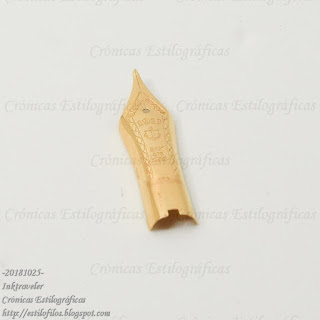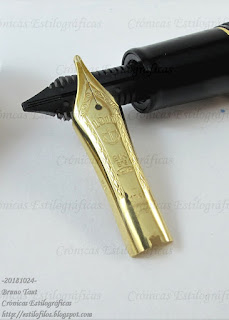My latest acquisition is an anonymous pen with a very non-anonymous nib. And this combination make the whole pen all the more intriguing, and, for some, appealing.
The pen, in essence, is a
Japanese eyedropper, made of ebonite with a very discreet maki-e decoration –a
"tanzaku" (poem cards) pattern. The clip is of the teardrop shape, just like many Ban-ei pens.
 An anonymous pen. Other than the inscriptions on the nib, the only text on it says R14K, and is on the cap ring. The very discreet maki-e --a "tanzaku" pattern-- is not signed.
An anonymous pen. Other than the inscriptions on the nib, the only text on it says R14K, and is on the cap ring. The very discreet maki-e --a "tanzaku" pattern-- is not signed.
And this clip, together with the overall shape of the pen and the shape of the section, and even the geometry of the ebonite feed point out at
Ban-ei (Sakai Eisuke) as the master mind behind it. However, this idea is nothing but a guess, although this pen is very likely to have been made in the 1960s at Asakusa area in Tokyo.
 A Ban-ei pen (top) and the anonymous pen with an interesting nib. Note the similarities in the shape. The Ban-ei pen is larger in all dimensions.
A Ban-ei pen (top) and the anonymous pen with an interesting nib. Note the similarities in the shape. The Ban-ei pen is larger in all dimensions.
 Feeds and sections of the pens on the previous picture: Ban-ei on top, anonymous on bottom. This geometry of the feed was very common in Japan from the 1960s till well into the 1990s on smaller pen makers.
Feeds and sections of the pens on the previous picture: Ban-ei on top, anonymous on bottom. This geometry of the feed was very common in Japan from the 1960s till well into the 1990s on smaller pen makers.
The comes the nib—a beautiful music nib perfectly identifiable as made by
nibmeister Kubo Kohei. In fact, the nib inscription NK stands for Nobel Kubo, where
Nobel is one of the brands Mr. Kubo created during his career as nib maker. The nib is likely to be a replaced unit, but it could also show the origin of the pen itself. Then, is this a Nobel pen? Many a Nobel pen were anonymous –no brand name was imprinted on the pen--, but ebonite was not a typical material on that brand as Mr. Kubo doesn’t work with the lathe.
 The music nib by Kubo Kohei. It is made of steel and is gold plated. The inscriptions read " STANDARD / NK / (JIS mark) / IRIDIUM / < 3 > / NPK ".
The music nib by Kubo Kohei. It is made of steel and is gold plated. The inscriptions read " STANDARD / NK / (JIS mark) / IRIDIUM / < 3 > / NPK ".
All in all, not much we know for certain about this pen, but the nib, and the unpretentious decoration make it most interesting.
These are the dimensions of the pen:
Length closed: 138 mm
Length open: 119 mm
Length posted: 166 mm
Diameter: 13.7 mm
Weight: 16.7 g (dry)
Ink deposit: 2.3 ml
And the search for information continues…
Twsbi Eco with Kubo music nib – Aurora Black
Bruno Taut
Nakano, October 16th 2018
etiquetas: nibmeister Kubo Kohei, maki-e, Ban-ei, Nobel, marca desconocida, plumín, plumín musical

























